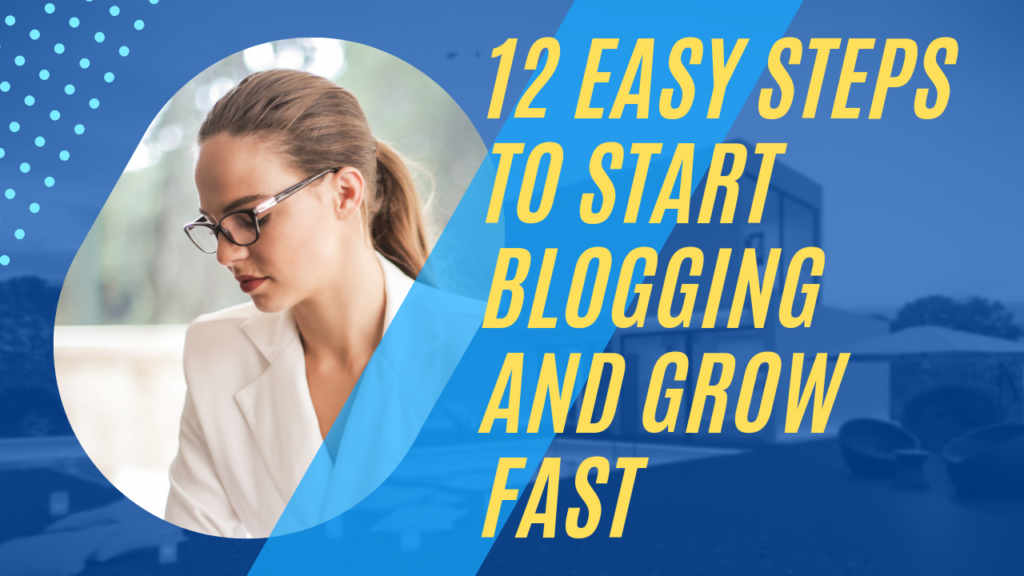Essentials
Blogging has become one of the most effective ways to share your knowledge ,Here are 12 easy steps to start blogging and grow fast and even make money online.
If you’re like to start a blog but don’t know where to start, you’re in the right place.
In this guide, I’ll walk you through 12 easy steps to start blogging and grow fast, helping you build a blog that attracts readers and gains momentum quickly.
Whether you’re looking to share your passion or create a profitable business, following these steps will set you on the path to success.
How long does it take to start earning money from a blog?
It can take anywhere from a few months to over a year to start earning money from a blog, depending on your niche, traffic, and monetization methods.
What is the best way to promote my blog?
Social media promotion, SEO, and networking with other bloggers are effective ways to drive traffic to your blog.
How often should I post on my blog?
Aim for consistency, whether it’s once a week or several times a month. Quality is more important than quantity.
Can I change my blog niche later?
Yes, but it’s best to stick with one niche to build authority and grow a loyal audience over time.
12 Easy Steps to Start Blogging and Grow Fast Tracking these goals will help you measure success.
Keep Learning and Adapting Staying updated on SEO, content marketing, and social media tactics is essential for continued growth, as blogging trends change frequently.
Adjust your strategy over time by regularly reviewing your performance and making improvements to your content, SEO, and promotional tactics.

Step 1: Choose Your Niche
Why Niche Selection is Critical
Selecting a niche is the foundation of a successful blog. Your niche determines your target audience, the topics you cover, and the type of monetization strategies you can use.
Picking a niche that you’re passionate about and knowledgeable in is crucial for long-term blogging success.
How to Find a Profitable Niche
To find a niche that works for you, consider your interests and expertise, and also analyze market demand.
Tools like Google Trends and Ubersuggest can help you identify popular search terms and trending topics.
Step 2: Select the Right Blogging Platform
WordPress vs. Other Platforms
When it comes to blogging platforms, WordPress is by far the most popular and flexible option.
While platforms like Wix and Squarespace offer beginner-friendly interfaces, they lack the customization and scalability that WordPress provides.
Why WordPress is the Best for Blogging
WordPress gives you full control over your blog, allows for SEO optimization, and offers thousands of themes and plugins that can enhance your site’s functionality.
Step 3: Pick a Domain Name

Tips for Choosing a Memorable Domain
Your domain name is your online identity. It should be unique, easy to remember, and relevant to your niche.
Stick with ”.com” domains if possible, as they are most recognized and trusted by users.
Where to Buy Your Domain
Popular domain registration services include GoDaddy, Namecheap, and Bluehost. These platforms offer affordable pricing and reliable customer support.
Step 4: Get Web Hosting
The Importance of Reliable Hosting
A good web hosting provider ensures that your blog is always accessible, loads quickly, and is secure from threats. Hosting performance directly affects your site’s ranking and user experience.
Recommended Hosting Providers
Top hosting providers like SiteGround, Bluehost, and HostGator are known for their reliability, speed, and excellent customer service.
Step 5: Design Your Blog
Choosing the Right Theme
Your blog design should reflect your brand and provide a seamless user experience. Choose a clean, responsive theme that works well on both desktop and mobile.
Optimizing for User Experience
Ensure your blog is easy to navigate, with clear categories and a fast-loading interface. Simple designs are often more effective and enhance your blog’s readability.
Step 6: Write Quality Content
Importance of Original and Engaging Content
Content is king in the blogging world. Your blog posts should be informative, engaging, and unique. Avoid plagiarism and make sure your content provides value to your readers.
How to Structure Your Posts
Use a clear structure in your blog posts with headings, subheadings, bullet points, and images to break up text. This makes your content easier to read and improves SEO.
Step 7: Implement SEO Best Practices
On-Page SEO Optimization
On-page SEO includes optimizing title tags, meta descriptions, and using targeted keywords throughout your content. Use tools like Yoast SEO to ensure your blog is SEO-friendly.
Off-Page SEO Strategies
Off-page SEO involves activities like guest blogging, backlinks, and social sharing. These strategies help boost your blog’s credibility and authority in your niche.
Step 8: Promote Your Blog on Social Media

Leveraging Social Platforms for Traffic
Social media platforms like Facebook, Twitter, Instagram, and Pinterest are powerful tools to promote your blog and attract visitors. Share your blog posts regularly and engage with your audience.
Building a Social Media Strategy
Create a consistent posting schedule, use relevant hashtags, and collaborate with influencers to expand your reach.
Step 9: Network with Other Bloggers
Benefits of Networking
Networking can lead to guest posting opportunities, backlinks, and increased visibility for your blog. Building relationships with other bloggers can significantly help your blog grow faster.
How to Collaborate with Other Bloggers
Reach out to other bloggers in your niche for collaborations, interviews, or content exchanges. This helps you tap into new audiences.
Step 10: Monetize Your Blog
Affiliate Marketing
Affiliate marketing is a popular way to monetize blogs. You can promote products or services and earn commissions for every sale made through your referral links.
Google AdSense and Sponsored Posts
Other monetization methods include displaying ads with Google AdSense or partnering with brands for sponsored content.
Step 11: Track Your Performance
Using Google Analytics
Google Analytics helps you track important metrics such as traffic, user behavior, and conversion rates. Use this data to adjust your strategies and improve your blog’s performance.
Setting Goals and Measuring Success
Set clear goals, such as reaching a specific number of visitors or increasing your email subscribers. Tracking these goals will help you measure success.
Step 12: Keep Learning and Adapting
Staying Updated with Blogging Trends
Blogging trends change frequently, so staying updated on SEO, content marketing, and social media tactics is essential for continued growth.
Adjusting Your Strategy Over Time
As your blog grows, you may need to adjust your strategy. Regularly review your performance and make improvements to your content, SEO, and promotional tactics.
SUMMARY
Starting a blog is an exciting and rewarding journey. By following these 12 steps, you can lay the foundation for a successful blog and ensure that it grows quickly. Remember, consistency and patience are key, and with the right strategies in place, your blog can become a profitable venture.




